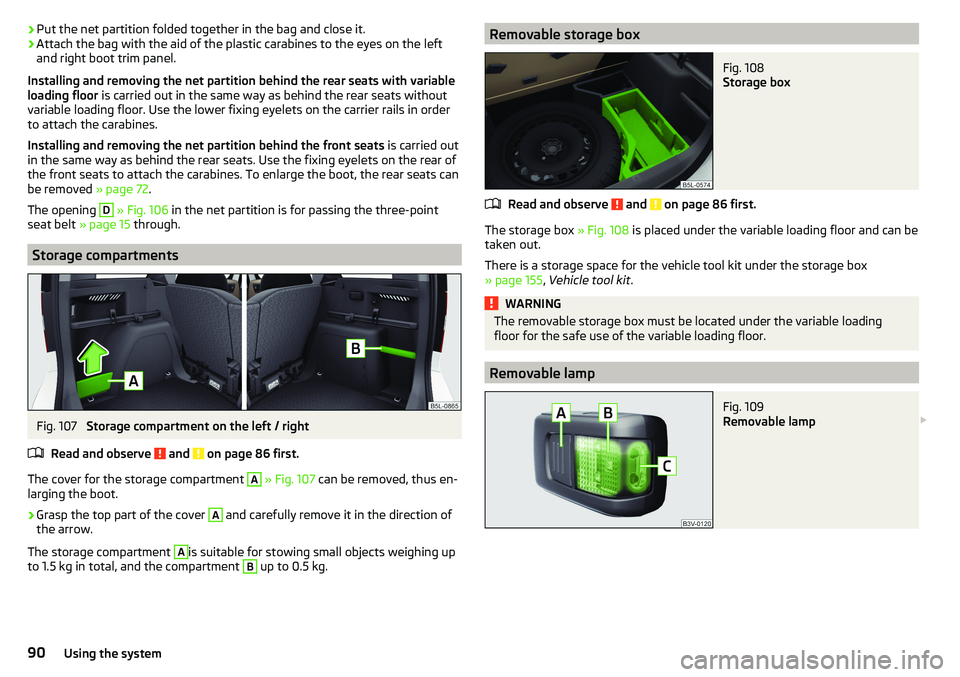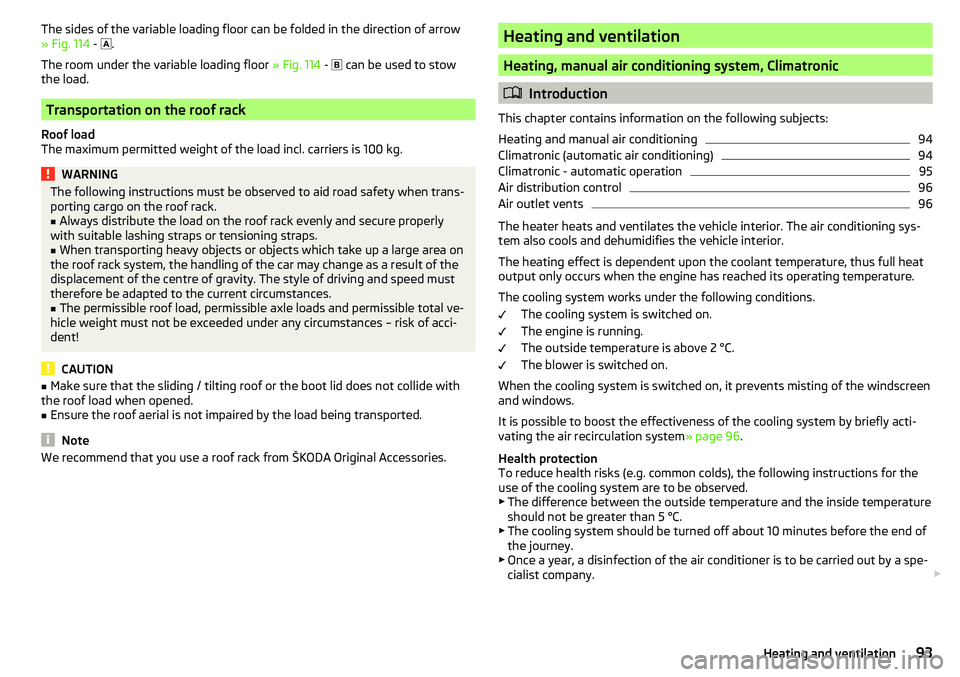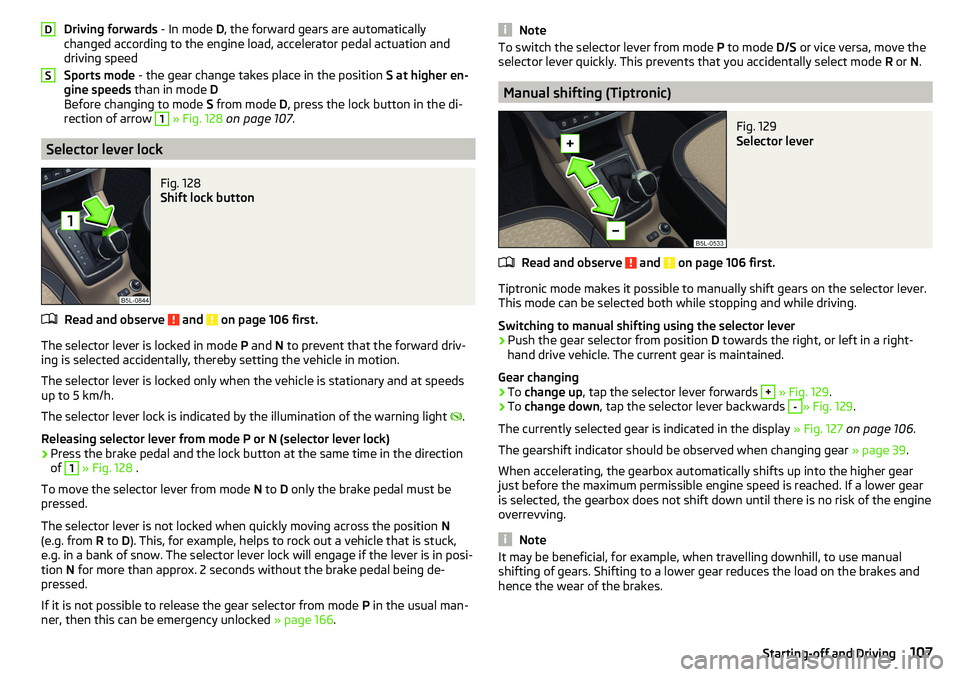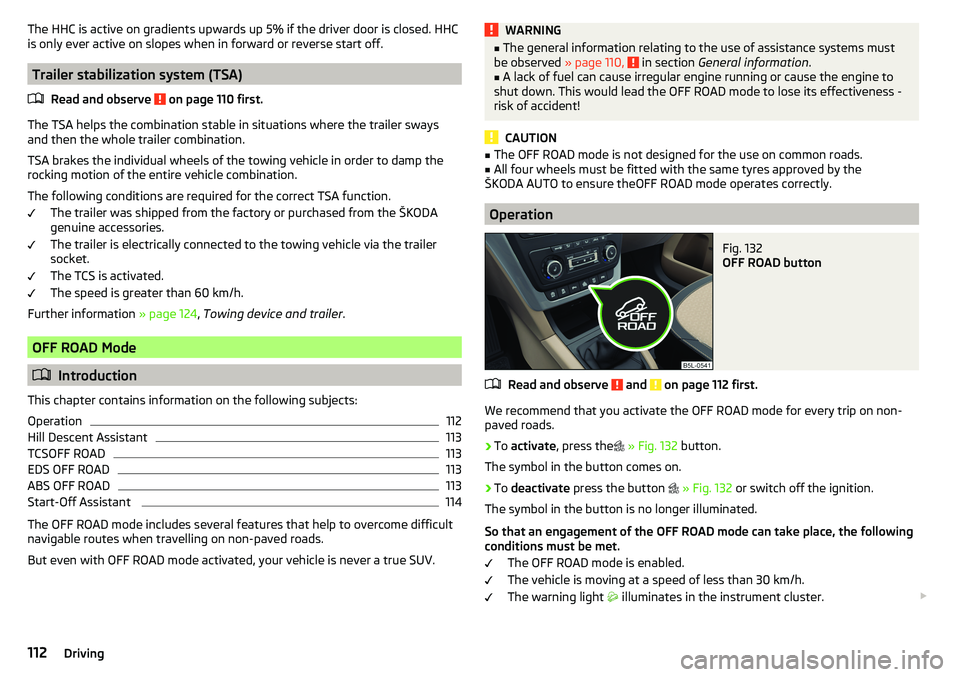tow SKODA YETI 2017 Owner´s Manual
[x] Cancel search | Manufacturer: SKODA, Model Year: 2017, Model line: YETI, Model: SKODA YETI 2017Pages: 200, PDF Size: 28.93 MB
Page 90 of 200

Fastening bar with sliding hookFig. 103
Sliding hook onto the mounting bar / removing hook
Read and observe
and on page 86 first.
A fastening bar is located on both sides of the luggage compartment with two
moveable hooks each, in order to attach small items of luggage, such as bags,
etc.
The maximum permissible load of each of the hooks is 7.5 kg.
Moving the hook
›
Fold up the hook in direction of arrow
1
» Fig. 103 until an angle of approx.
45° is reached.
›
Move the hook in the direction of the arrow
2
into the desired position and
fold down the hook as far as the stop in direction of arrow
3
.
Removing hooks
The hook can be removed only in the rear region of the attachment bar.
›
Fold the hook upwards in direction of arrow
4
» Fig. 103 until it disengages,
and remove in the direction of arrow
5
.
Inserting hook
›
Position the hook on the fastening strip in a vertical position in direction of
arrow
5
» Fig. 103 and lightly press it on.
›
Fold the hook up to the stop away from arrow
4
until it locks.
Flexible storage compartmentFig. 104
Flexible storage compartment
Read and observe and on page 86 first.
The flexible storage compartment can be installed on the right-hand side of
the boot » Fig. 104 .
The storage compartment is designed for storing small objects with a maxi-
mum total weight of 8 kg.
›
To use ,insert the two ends of the storage compartment into the openings in
the side trim of the luggage compartment and push the shelf down to lock.
›
To remove grasp the storage compartment on both top edges, press the up-
per corners inwards and release the storage compartment by pulling up-
wards.
›
Remove the storage compartment by pulling towards you.
CAUTION
The flexible storage compartment cannot be installed on vehicles with the var-
iable loading floor.
Floor covering on both sides
Read and observe
and on page 86 first.
You can fit a double-sided floor covering in the luggage compartment. One
side is made of fabric, the other side is washable (suitable for transporting wet
or dirty items).
88Using the system
Page 92 of 200

›Put the net partition folded together in the bag and close it.›Attach the bag with the aid of the plastic carabines to the eyes on the left
and right boot trim panel.
Installing and removing the net partition behind the rear seats with variable
loading floor is carried out in the same way as behind the rear seats without
variable loading floor. Use the lower fixing eyelets on the carrier rails in order
to attach the carabines.
Installing and removing the net partition behind the front seats is carried out
in the same way as behind the rear seats. Use the fixing eyelets on the rear of
the front seats to attach the carabines. To enlarge the boot, the rear seats can
be removed » page 72.
The opening D
» Fig. 106 in the net partition is for passing the three-point
seat belt » page 15 through.
Storage compartments
Fig. 107
Storage compartment on the left / right
Read and observe
and on page 86 first.
The cover for the storage compartment
A
» Fig. 107 can be removed, thus en-
larging the boot.
›
Grasp the top part of the cover
A
and carefully remove it in the direction of
the arrow.
The storage compartment
A
is suitable for stowing small objects weighing up
to 1.5 kg in total, and the compartment
B
up to 0.5 kg.
Removable storage boxFig. 108
Storage box
Read and observe and on page 86 first.
The storage box » Fig. 108 is placed under the variable loading floor and can be
taken out.
There is a storage space for the vehicle tool kit under the storage box
» page 155 , Vehicle tool kit .
WARNINGThe removable storage box must be located under the variable loading
floor for the safe use of the variable loading floor.
Removable lamp
Fig. 109
Removable lamp
90Using the system
Page 95 of 200

The sides of the variable loading floor can be folded in the direction of arrow
» Fig. 114 - .
The room under the variable loading floor » Fig. 114 -
can be used to stow
the load.
Transportation on the roof rack
Roof load
The maximum permitted weight of the load incl. carriers is 100 kg.
WARNINGThe following instructions must be observed to aid road safety when trans-
porting cargo on the roof rack.■
Always distribute the load on the roof rack evenly and secure properly
with suitable lashing straps or tensioning straps.
■
When transporting heavy objects or objects which take up a large area on
the roof rack system, the handling of the car may change as a result of the
displacement of the centre of gravity. The style of driving and speed must
therefore be adapted to the current circumstances.
■
The permissible roof load, permissible axle loads and permissible total ve-
hicle weight must not be exceeded under any circumstances – risk of acci-
dent!
CAUTION
■ Make sure that the sliding / tilting roof or the boot lid does not collide with
the roof load when opened.■
Ensure the roof aerial is not impaired by the load being transported.
Note
We recommend that you use a roof rack from ŠKODA Original Accessories.Heating and ventilation
Heating, manual air conditioning system, Climatronic
Introduction
This chapter contains information on the following subjects:
Heating and manual air conditioning
94
Climatronic (automatic air conditioning)
94
Climatronic - automatic operation
95
Air distribution control
96
Air outlet vents
96
The heater heats and ventilates the vehicle interior. The air conditioning sys-
tem also cools and dehumidifies the vehicle interior.
The heating effect is dependent upon the coolant temperature, thus full heat
output only occurs when the engine has reached its operating temperature.
The cooling system works under the following conditions. The cooling system is switched on.
The engine is running.
The outside temperature is above 2 °C.
The blower is switched on.
When the cooling system is switched on, it prevents misting of the windscreen
and windows.
It is possible to boost the effectiveness of the cooling system by briefly acti-
vating the air recirculation system » page 96.
Health protection
To reduce health risks (e.g. common colds), the following instructions for the
use of the cooling system are to be observed. ▶ The difference between the outside temperature and the inside temperature
should not be greater than 5 °C.
▶ The cooling system should be turned off about 10 minutes before the end of
the journey.
▶ Once a year, a disinfection of the air conditioner is to be carried out by a spe-
cialist company.
93Heating and ventilation
Page 109 of 200

Driving forwards - In mode D, the forward gears are automatically
changed according to the engine load, accelerator pedal actuation and
driving speed
Sports mode - the gear change takes place in the position S at higher en-
gine speeds than in mode D
Before changing to mode S from mode D, press the lock button in the di-
rection of arrow 1
» Fig. 128 on page 107 .
Selector lever lock
Fig. 128
Shift lock button
Read and observe and on page 106 first.
The selector lever is locked in mode P and N to prevent that the forward driv-
ing is selected accidentally, thereby setting the vehicle in motion.
The selector lever is locked only when the vehicle is stationary and at speeds
up to 5 km/h.
The selector lever lock is indicated by the illumination of the warning light .
Releasing selector lever from mode P or N (selector lever lock)
›
Press the brake pedal and the lock button at the same time in the direction
of
1
» Fig. 128 .
To move the selector lever from mode N to D only the brake pedal must be
pressed.
The selector lever is not locked when quickly moving across the position N
(e.g. from R to D). This, for example, helps to rock out a vehicle that is stuck,
e.g. in a bank of snow. The selector lever lock will engage if the lever is in posi-
tion N for more than approx. 2 seconds without the brake pedal being de-
pressed.
If it is not possible to release the gear selector from mode P in the usual man-
ner, then this can be emergency unlocked » page 166.
DSNoteTo switch the selector lever from mode P to mode D/S or vice versa, move the
selector lever quickly. This prevents that you accidentally select mode R or N.
Manual shifting (Tiptronic)
Fig. 129
Selector lever
Read and observe and on page 106 first.
Tiptronic mode makes it possible to manually shift gears on the selector lever.
This mode can be selected both while stopping and while driving.
Switching to manual shifting using the selector lever
›
Push the gear selector from position D towards the right, or left in a right-
hand drive vehicle. The current gear is maintained.
Gear changing
›
To change up , tap the selector lever forwards
+
» Fig. 129 .
›
To change down , tap the selector lever backwards
-
» Fig. 129.
The currently selected gear is indicated in the display » Fig. 127 on page 106 .
The gearshift indicator should be observed when changing gear » page 39.
When accelerating, the gearbox automatically shifts up into the higher gear
just before the maximum permissible engine speed is reached. If a lower gear
is selected, the gearbox does not shift down until there is no risk of the engine
overrevving.
Note
It may be beneficial, for example, when travelling downhill, to use manual
shifting of gears. Shifting to a lower gear reduces the load on the brakes and
hence the wear of the brakes.107Starting-off and Driving
Page 114 of 200

The HHC is active on gradients upwards up 5% if the driver door is closed. HHC
is only ever active on slopes when in forward or reverse start off.
Trailer stabilization system (TSA)
Read and observe
on page 110 first.
The TSA helps the combination stable in situations where the trailer sways
and then the whole trailer combination.
TSA brakes the individual wheels of the towing vehicle in order to damp the rocking motion of the entire vehicle combination.
The following conditions are required for the correct TSA function. The trailer was shipped from the factory or purchased from the ŠKODA
genuine accessories.
The trailer is electrically connected to the towing vehicle via the trailer
socket.
The TCS is activated.
The speed is greater than 60 km/h.
Further information » page 124, Towing device and trailer .
OFF ROAD Mode
Introduction
This chapter contains information on the following subjects:
Operation
112
Hill Descent Assistant
113
TCSOFF ROAD
113
EDS OFF ROAD
113
ABS OFF ROAD
113
Start-Off Assistant
114
The OFF ROAD mode includes several features that help to overcome difficult
navigable routes when travelling on non-paved roads.
But even with OFF ROAD mode activated, your vehicle is never a true SUV.
WARNING■ The general information relating to the use of assistance systems must
be observed » page 110, in section General information .■
A lack of fuel can cause irregular engine running or cause the engine to
shut down. This would lead the OFF ROAD mode to lose its effectiveness -
risk of accident!
CAUTION
■ The OFF ROAD mode is not designed for the use on common roads.■All four wheels must be fitted with the same tyres approved by the
ŠKODA AUTO to ensure theOFF ROAD mode operates correctly.
Operation
Fig. 132
OFF ROAD button
Read and observe and on page 112 first.
We recommend that you activate the OFF ROAD mode for every trip on non- paved roads.
›
To activate , press the
» Fig. 132 button.
The symbol in the button comes on.
›
To deactivate press the button
» Fig. 132 or switch off the ignition.
The symbol in the button is no longer illuminated.
So that an engagement of the OFF ROAD mode can take place, the following conditions must be met.
The OFF ROAD mode is enabled.
The vehicle is moving at a speed of less than 30 km/h. The warning light
illuminates in the instrument cluster.
112Driving
Page 117 of 200

Fig. 134
Sampled areas and range of the
sensors
Read and observe and on page 114 first.
The system uses ultrasound waves to calculate the distance between the
bumper and an obstacle. The ultrasonic sensors are, depending on vehicle
equipment, located in the back or in the front bumper » Fig. 133.
Depending on the equipment, the following system variants are possible
» Fig. 134 .
▶ Variant 1: warns of obstacles in the areas
C
,
D
.
▶ Variant 2: warns of obstacles in the areas
A
,
B
,
C
,
D
.
▶ Variant 3: warns of obstacles in the areas
A
,
B
,
C
,
D
,
E
.
Approximate range of sensors (in cm)
Area » Fig. 134Variant 1
(4 sensors)Variant 2
(8 sensors)Variant 3
(12 sensors)A-120120B-6060C160160160D606060E--60
Audible signals
The interval between the acoustic signals becomes shorter as the clearance is
reduced. At a distance of approx. 30 cm, a continuous tone starts to sound -
danger zone. From this moment do not continue to move towards the obsta-
cle!
Towing a trailer
When towing, or when another accessory is connected to the trailer socket on-
ly the areas
A
and
B
» Fig. 134 are active in the system.
Note■
If with Version 3 vehicles not all fields around the vehicle are active after ac-
tivation the vehicle should be moved forwards or backwards.■
The signal tones for front obstacle recognition are factory-set to be higher
than for rear obstacle recognition.
■
The sound of the park-assist can be adjusted via the MAXI DOT display in the
Assistants
menu option » page 43.
Display in the Infotainment display
Fig. 135
Display
Read and observe and on page 114 first.
Functional interfaces and obstacle warning » Fig. 135
Change to rear-view camera display .
Switching off park assistant display. Switching audible parking signals on/off.
Message:
Look! Safe to move?
An area without detected obstacles is shown as a transparent segment.
An obstacle which is currently outside of the collision area is shown by the
yellow segment.
An obstacle in the collision zone is shown as an orange-coloured segment.
Stop moving in the direction of the obstacle!
ABC115Assist systems
Page 126 of 200

Towing device and trailer
Hitch
Introduction
This chapter contains information on the following subjects:
Description
124
Setting the ready position
125
Check the setting of the standby position
125
Assemble the ball rod
125
Check proper mounting
126
Removing ball rod - Step 1
126
Removing ball rod - Step 2
127
Vertical load with mounted accessories
127
The maximum trailer nose weight when towing a trailer is 80 kg, for vehicles
with four-wheel drive and the 2.0 l / 103 kW TDI CR or 2.0 l / 110 kW TDI CR
engine, it is 85 kg. Other information (e.g. on the nameplate of the trailer de-
vice) provide only about the test values of the device information.
WARNING■ Check that the tow bar is seated correctly and is secured in the mounting
recess before the start of every journey.■
When the ball rod is not used and properly secured in the receiving shaft,
this could be damaged or incomplete and must not be used -There is a risk
of an accident.
■
Do not modify or adapt the towing device in any way.
■
Keep the mounting recess of the towing equipment clean at all times.
Such dirt prevents the ball head from being attached securely.
DescriptionFig. 143
Carrier for the towing device/tow bar
Read and observe
on page 124 first.
The ball rod is detachable and is located in the stowage compartment for the
spare / emergency wheel.
Support for the towing device and tow bar » Fig. 143
13-pin power socket
Mounting recess
Safety eyelet
Cover for the mounting recess
Dust cap
Locking ball
Green marking on the handwheel
Handwheel
Key
Lock cap
Red marking on the handwheel
Green box on the tow bar
Tow ball
12345678910111213124Driving
Page 127 of 200

Setting the ready positionFig. 144
Lock unlock / pull out hand wheel and turn
Read and observe
on page 124 first.
The tow bar must be set to the ready position prior to installation » page 125,
Check the setting of the standby position .
›
Grip the tow bar below the protective cap.
›
Remove the cap from the lock.
›
Insert the key into the hand wheel lock.
›
Turn the key
A
in direction of the arrow
1
to the stop » Fig. 144.
›
Pull the handwheel
B
in the direction of the arrow
2
and drag in the direc-
tion of the arrow
3
to the stop. The hand wheel
B
remains locked in this
position.
Check the setting of the standby position
Fig. 145
Ready position
Read and observe on page 124 first.
Correctly adjusted standby position » Fig. 145
The locking balls
A
can be pushed fully into the tow bar.
The red marking
B
on the hand wheel is located in the green box on the
tow bar.
The key
C
is in the unlocked position and cannot be removed.
There is a clear gap of approx. 5 mm
D
between the hand wheel and the
tow bar.
When in the ready position, the key cannot be removed from the lock. The ball
bar is thus set ready for installation.
Assemble the ball rod
Fig. 146
Removing the cap on the rear bumper/inserting the tow bar
125Towing device and trailer
Page 128 of 200

Fig. 147
Locking the lock and removing the key/replacing the lock cap
Read and observe
on page 124 first.
›
Grip the cap on the rear bumper
B
» Fig. 146 at the handle
A
, release in the
direction of the arrow
1
and remove in the direction of the arrow
2
.
›
Remove the cover for the mounting recess
4
» Fig. 143 on page 124 in a
downwards direction.
›
Adjust the ball rod to the ready position » page 125.
›
Grasp the ball rod from underneath » Fig. 146 and install into the receiving
shaft in the direction of arrow
3
until it stops. The ball rod must audibly
snap into place » .
The handwheel
C
» Fig. 146 returns automatically and rests on the tow bar
» .
›
Lock the handwheel lock by turning the key
D
» Fig. 147 to the left in the
direction of the arrow
4
to the stop, and remove the key in the direction of
the arrow
5
.
›
Put the cap
E
onto the handwheel lock in the direction of the arrow
6
.
›
Check that the tow bar is securely attached » page 126.
WARNING■
When attaching the tow bar, do not hold the handwheel by hand - risk of
injuring fingers!■
Carefully remove the cap for the mounting recess - there is a risk of hand
injury!
Check proper mountingFig. 148
Correctly secured ball head
Read and observe on page 124 first.
Correctly secured ball rod » Fig. 148
The tow bar does not come out of the mounting recess even after heavy
“shaking”.
The green marking
A
on the handwheel is located in the green box on the
tow bar.
The steering wheel is tight against the ball rod.
The key is removed and the cap
C
is attached to the lock.
Removing ball rod - Step 1
Fig. 149
Removing the lock cover/releasing the lock
Read and observe
on page 124 first.
No trailer or other accessory is connected to the ball rod. We recommend put-
ting the protective cover onto the ball head before removing the ball rod.
126Driving
Page 129 of 200

›Remover the cover A from the handwheel lock in the direction of the arrow1
» Fig. 149 .›
Insert the key into the handwheel lock.
›
Turn the key
B
2
in the direction of the arrow as far as the stop.
Removing ball rod - Step 2
Fig. 150
Removing the two bar/placing the cover on the rear bumper
Read and observe
on page 124 first.
Removing
›
Grip the tow bar from below and with the other hand pull the handwheel
C
in the direction of the arrow
3
» Fig. 150 .
›
Turn the handwheel in the direction of the arrow
4
to the stop , and hold in
this position.
›
Remove the tow bar from the mounting recess downwards and in the direc-
tion of the arrow
5
. At the same time, the ball rod latches into the ready po-
sition and is therefore ready to be re-fitted.
After removing the ball rod
›
Attach the cover for the mounting recess
4
» Fig. 143 on page 124 .
›
Grip the cover on the rear bumper
E
» Fig. 150 at the handle
D
and position
in the direction of the arrow
6
on the checkmark underneath the upper
edge of the bumper.
›
Push this cover onto the lower edge and onto the two sides in the direction
of the arrow
7
.
If the hand wheel
C
is not turned all the way to the stop, then it will return to
its initial position when the tow bar is removed and will rest on the tow bar
and not engage into the ready position. The ball head then needs to be
brought into this position before the next time it is fitted » page 125.
The ball rod must be cleaned before storing in the box with the vehicle tool
always.WARNINGNever allow the tow bar to remain unsecured in the boot. This could cause
damage to the boot upon sudden braking, and could put the safety of the
occupants at risk!
Vertical load with mounted accessories
Fig. 151
Representation of the maximum
length of the mounted accesso-
ries and the permissible total
weight of the accessory depend-
ing on the load centre of gravity
Read and observe on page 124 first.
When using the accessories (e.g. bicycle carrier), the maximum length and the
permissible total weight including load must be considered.
The maximum length of the mounted accessories (from the ball of the towing
device) is 70 cm » Fig. 151 .
The total permitted weight of the accessories including load changes with in-
creasing distance of the load centre of gravity from the ball head of the towing
device.
Distance of the centre of gravity of the load from the ball headPermissible total weight of the ac- cessories, including load0 cm75 kg30 cm75 kg60 cm35 kg70 cm0 kg
CAUTION
Never exceed the permissible total weight of the accessories incl. load and
maximum length of the accessories - risk of damage to the towing device. 127Towing device and trailer